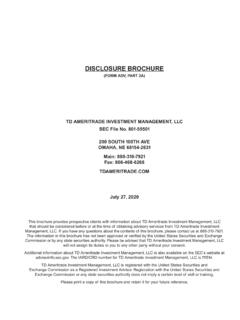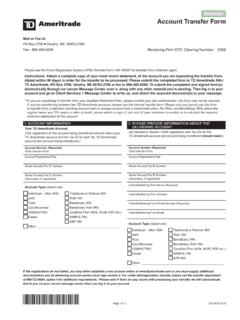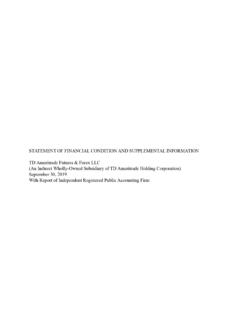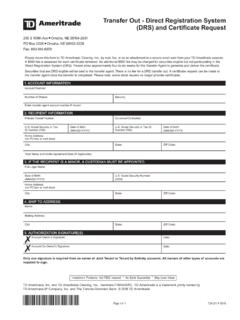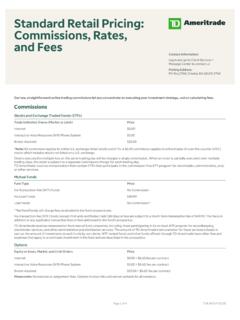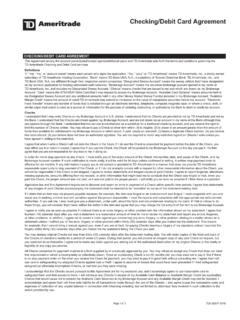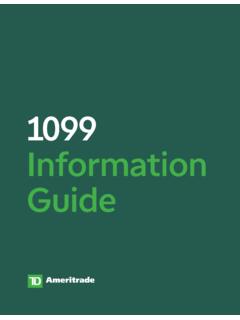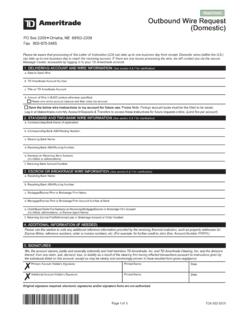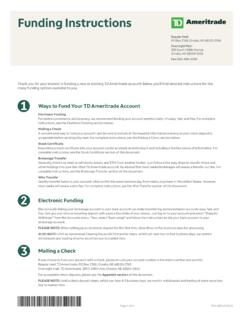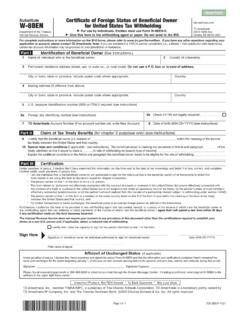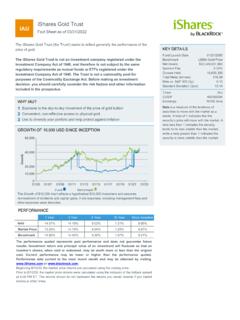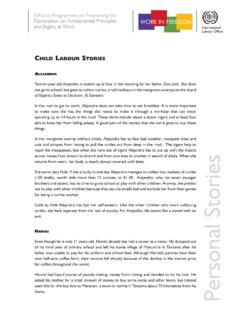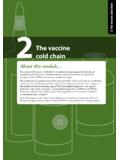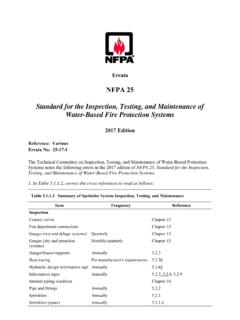Transcription of Inverse-Leverage ETP Disclaimers - TD Ameritrade
1 TDA 101509 02/21 Page 1 of 1 What are Leveraged, Inverse, and Commodity Exchange-Traded Products (ETPs)?Leveraged ETPsAs the name implies, these ETPs (both ETFs and ETNs) seek to provide leveraged returns based on the performance of an underlying index. It's important to note that these leveraged returns are generated on a daily (occasionally monthly) basis. Due to the impact of what is known as daily compounding, investors should not expect the promised daily leverage of these returns to persist over periods longer than a day. This is especially true if the leveraged ETP is tracking a very volatile underlying index. Leveraged ETPs provide daily returns that are generally 3x, 2x, -2x, or -3x of the underlying index performance.
2 Leveraged ETPs generate their leverage through the use of derivative positions. Because derivatives are taxed differently from equity or fixed-income securities, investors should be aware that these ETPs may not have the same tax efficiencies that investors have come to expect from many ETPs. It is important to remember that most of these securities are designed for daily use only, and are not intended to be held overnight or long ETPs These products (both ETFs and ETNs) are related to leveraged ETPs in that they seek to provide -1x return on an underlying index. Similar to leveraged ETPs, this inverse return is provided on a daily basis, and investors should not expect the promised daily leverage of these returns to persist over periods longer than a day.
3 Inverse ETFs generate their returns through the use of derivative positions. Because derivatives are taxed differently from equity or fixed-income securities, investors should be aware that these products may not have the same tax efficiencies that investors have come to expect from many ETPs. It is important to remember that most of these securities are designed for daily use only, and are not intended to be held overnight or long term. Commodity ETPsThese products (both ETFs and ETNs) provide exposure to commodities through a variety of underlying holdings and structures. Several most notably in the precious-metals space hold actual physical commodities in a trust.
4 However, that is more the exception than the rule. Most of these products hold or track indexes based on futures and other derivative products. This important distinction means that the promised return of the product is not actually the spot price of the underlying commodity or basket of commodities, but rather the return from a strategy that holds futures contracts and rolls them as dictated by the rules governing the underlying index. Investors in these products should be familiar with the specifics of how futures curves work, especially in terms of backwardation and contango. The performance of commodity ETPs tracking commodities whose futures curves are in severe backwardation or contango have a high likelihood of experiencing returns that deviate from the returns of spot price , commodity ETPs come in the form of trusts for precious metals, ETFs that are in reality limited partnerships, and exchange-traded notes (ETNs).
5 The taxation and other risks are unique to each of these products. Precious-metals trusts, such as SPDR Gold Shares (GLD), are taxed similarly to a collectible, so all gains will be taxed at ordinary income rates. Because commodity ETFs actually hold futures and other derivatives, they are subject to the same tax treatment these instruments would face if held individually and will be less tax-efficient than ETFs holding stocks or bonds. ETNs are taxed like bonds, making them more tax-efficient than their commodity ETF counterparts, but there is a trade-off. Because ETNs are essentially promissory notes backed by a bank, holders of these products face credit risk should the backing bank become insolvent.
6 RISK DISCLOSURES: PLEASE READ IMPORTANT ADDITIONAL MUTUTAL FUND, EXCHANGE-TRADED FUND, AND CLOSED-END FUND RISK consider the investment objectives, risks, charges and expenses before investing. A prospectus, obtained by calling 800-669-3900, contains this and other important information about an investment company. Read carefully before are baskets of securities that may track a sector-specific, country-specific, or a narrow/broad-market index. ETFs trade on an exchange like a stock. ETFs are subject to risk similar to those of their underlying securities, including, but not limited to, market, sector, or industry risks, and those regarding short-selling and margin account maintenance.
7 Commission fees typically ETFs may be affected by changes in overall market movements, commodity index volatility, changes in interest rates or factors affecting a particular industry or commodity. Commodity ETFs may be subject to greater volatility than traditional ETFs and may not be suitable for all investors. Unique risk factors of a commodity fund may include, but are not limited to the fund's use of aggressive investment techniques such as derivatives, options, forward contracts, correlation or inverse correlation, market price variance risk and are not funds and are not registered investment companies. ETNs are not secured debt and most do not provide principal protection.
8 ETNs involve credit risk. The repayment of the principal, any interest, and the payment of any returns at maturity or upon redemption depend on the issuer's ability to pay. The market value of an ETN may be impacted if the issuer's credit rating is downgraded. ETNs may be subject to specific sector or industry risks. ETNs containing components traded in foreign currencies are subject to foreign exchange risk. ETNs may have call features that allow the issuer to call the ETN. A call right by an issuer may adversely affect the value of the Ameritrade does not provide tax or legal advice. Information provided by TD Ameritrade is intended for educational/informational purposes only.
9 Not investment advice, or a recommendation of any security, strategy, or account type. Inverse-Leverage ETP DisclaimersInvestment Products: Not FDIC Insured * No Bank Guarantee * May Lose ValueTD Ameritrade , Inc., member FINRA/SIPC, a subsidiary of The Charles Schwab Corporation. TD Ameritrade is a trademark jointly owned by TD Ameritrade IP Company, Inc. and The Toronto-Dominion Bank. 2021 Charles Schwab & Co. Inc. All rights reserved.
